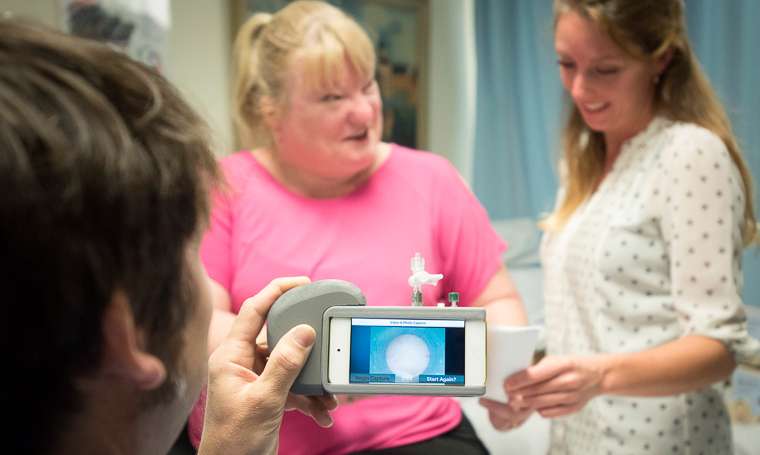Smarter diagnosis for lipoedema

A new handheld device and app will help clinicians diagnose lipoedema – a condition characterised by swollen limbs – earlier and better monitor the success of treatment options.
The device, which is made up of a small pump and a smartphone, was developed by the South Australian Biomedical Engineering Research and Teaching team at Flinders Medical Centre and was modelled on a angiosterrometre – a device that can pull and hold suction for 30 seconds.
Lymphoedema Research Unit Director Professor Neil Piller, who approached the teaching team to develop the device, said he hoped the device would help clinicians detect the condition much earlier – before the limbs start to swell – and allow for proactive management of the condition.
He said the device works by creating a negative pressure under the cup, which is held for 30 seconds. While the pressure is held, the smartphone app is able to take video and pictures showing changes in the skin colour – a sign of potential vascular problems.
"We then look at the videos and photos to see how much change in skin colour there is – someone without lipoedema would show no change while a patient with weakened blood vessels (as in lipoedema) do show changes," Professor Piller said.
"We have long known that people with lipoedema bruise easily and that is due to poor microcirculatory structure, so if we can detect this early then we can help the patient strengthen these vessels and also make recommendations regarding a change in diet."
Lipoedema is a chronic heritable condition, in which the micro circulation (small blood and lymph vessels) do not form normally and thereby do not function as they should.
The condition typically progresses to the abnormal build-up of fat cells in the legs, thighs and buttocks and is most commonly found in women.
Professor Piller said previously many patients with lipoedema could not be diagnosed until the condition had fully developed, meaning treatment was more reactive.
"This device will allow us to be more proactive and importantly we hope it will also help to show how effective our treatment and management strategies are," he said.
"It will mean better, more targeted advice and treatment for patients and will also help with diagnosis as many lipoedemas are wrongly diagnosed as lymphodemas (caused by damage to lymph nodes).
Senior Biomedical Technician Rob Smith said development of the angiosterrometre and the smartphone app took about five months, with the help of third-year Flinders University Biomedical Engineering honours student Kai Harrison.
"Neil approached our department with a request for a device that could pull and hold suction – he had read an abstract in a clinical publication which used a manual pump (angiosterrometre) – to be used for the diagnosis of lipoedema," Rob said.
"We then researched lipoedema and the device to see if there was currently anything commercially available, which there wasn't.
"We researched and tested a few different options before moving to an automated angiosterrometre, which would pull the exact amount of required suction.
"The device housing and electronics were all manufactured in the department, and we undertook in house testing before the clinical trial was initiated."
The Lymphoedema Research Unit is currently undertaking a pilot trial with the device, comparing the skin changes in patients with clinically-diagnosed lipoedema to those who have lymphoedema and those without either condition.




















